5DVP: Developing Professional Practice Report - [University Name]
VerifiedAdded on 2023/01/17
|23
|4658
|80
Report
AI Summary
This report, titled "Developing Professional Practice," details a student's exploration of key HR concepts and practices. Activity 1 examines the role of an effective HR professional, referencing the CIPD's code of conduct and professional competency map, and the importance of leadership and strategic thinking. Activity 2 focuses on group dynamics, explaining Tuckman's stages of group development and conflict resolution methods such as mediation and grievance processes. Activity 3 analyzes project management techniques and problem-solving, using a case study involving Qatar Foundation and succession planning. It covers project stages, tools like Fishbone diagrams and WBS, critical path analysis, and influencing skills. Activity 4 provides a self-assessment against the CIPD 2018 Profession Map. The report demonstrates a practical understanding of HR principles and their application in real-world scenarios.
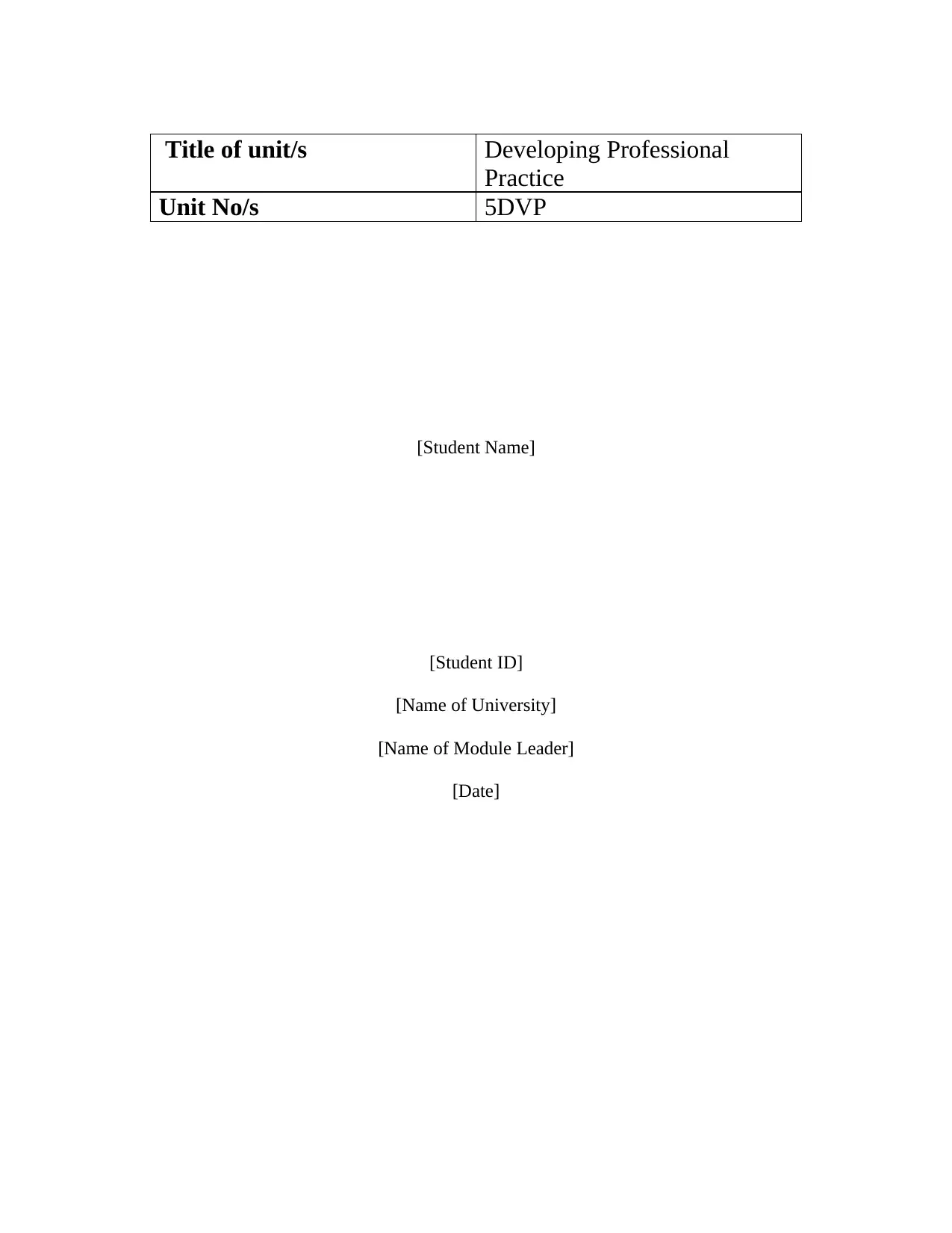
Title of unit/s Developing Professional
Practice
Unit No/s 5DVP
[Student Name]
[Student ID]
[Name of University]
[Name of Module Leader]
[Date]
Practice
Unit No/s 5DVP
[Student Name]
[Student ID]
[Name of University]
[Name of Module Leader]
[Date]
Paraphrase This Document
Need a fresh take? Get an instant paraphrase of this document with our AI Paraphraser
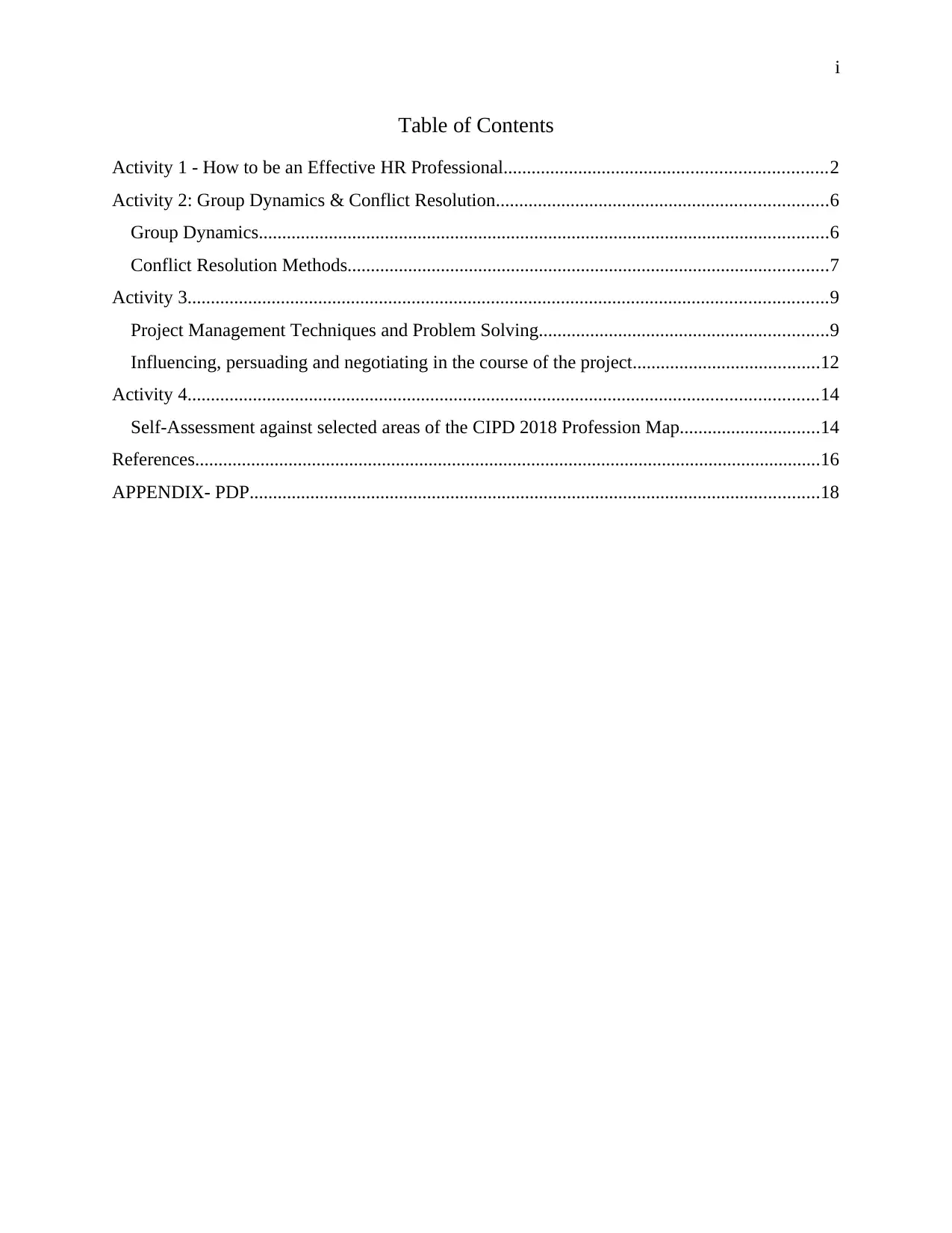
i
Table of Contents
Activity 1 - How to be an Effective HR Professional.....................................................................2
Activity 2: Group Dynamics & Conflict Resolution.......................................................................6
Group Dynamics..........................................................................................................................6
Conflict Resolution Methods.......................................................................................................7
Activity 3.........................................................................................................................................9
Project Management Techniques and Problem Solving..............................................................9
Influencing, persuading and negotiating in the course of the project........................................12
Activity 4.......................................................................................................................................14
Self-Assessment against selected areas of the CIPD 2018 Profession Map..............................14
References......................................................................................................................................16
APPENDIX- PDP..........................................................................................................................18
Table of Contents
Activity 1 - How to be an Effective HR Professional.....................................................................2
Activity 2: Group Dynamics & Conflict Resolution.......................................................................6
Group Dynamics..........................................................................................................................6
Conflict Resolution Methods.......................................................................................................7
Activity 3.........................................................................................................................................9
Project Management Techniques and Problem Solving..............................................................9
Influencing, persuading and negotiating in the course of the project........................................12
Activity 4.......................................................................................................................................14
Self-Assessment against selected areas of the CIPD 2018 Profession Map..............................14
References......................................................................................................................................16
APPENDIX- PDP..........................................................................................................................18
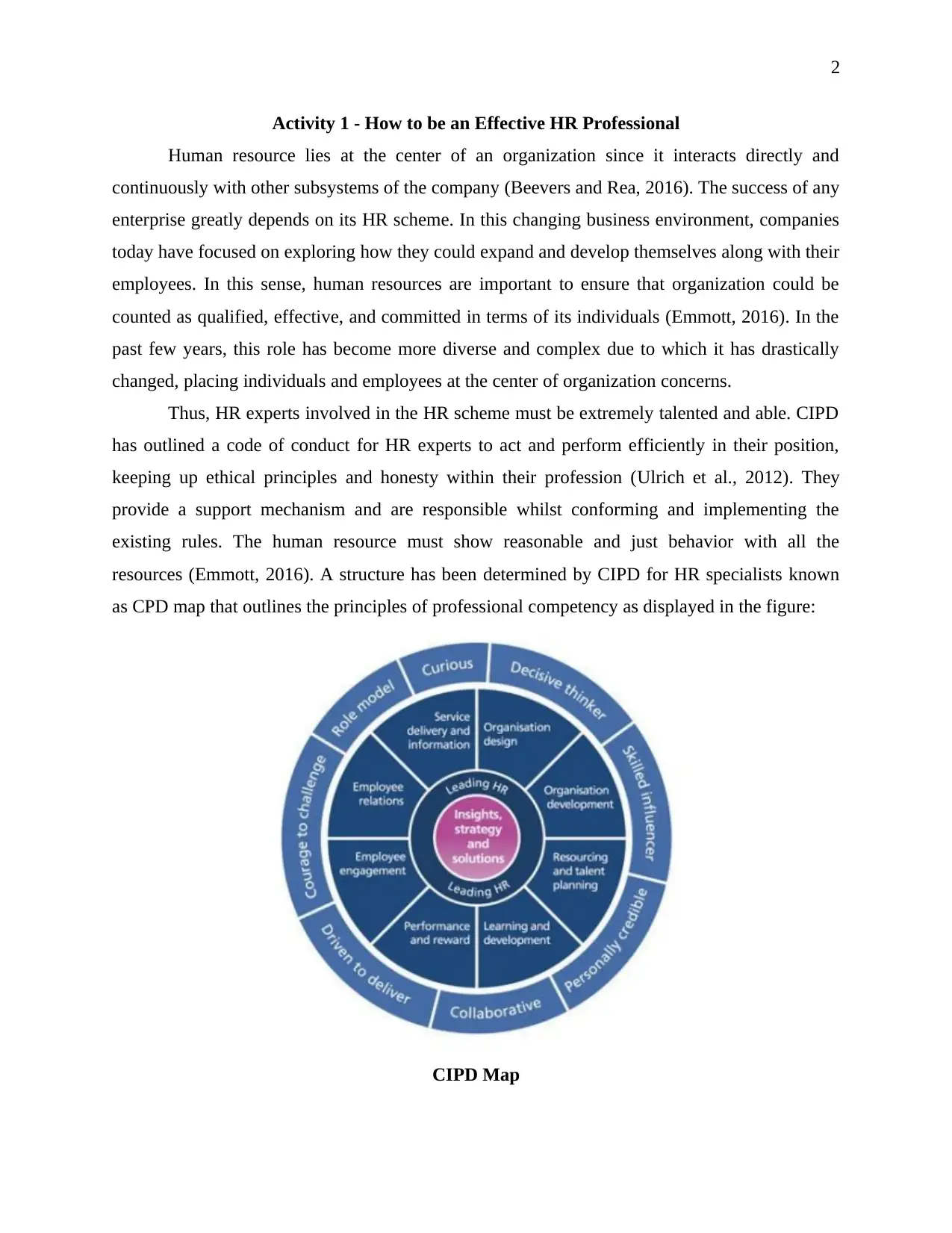
2
Activity 1 - How to be an Effective HR Professional
Human resource lies at the center of an organization since it interacts directly and
continuously with other subsystems of the company (Beevers and Rea, 2016). The success of any
enterprise greatly depends on its HR scheme. In this changing business environment, companies
today have focused on exploring how they could expand and develop themselves along with their
employees. In this sense, human resources are important to ensure that organization could be
counted as qualified, effective, and committed in terms of its individuals (Emmott, 2016). In the
past few years, this role has become more diverse and complex due to which it has drastically
changed, placing individuals and employees at the center of organization concerns.
Thus, HR experts involved in the HR scheme must be extremely talented and able. CIPD
has outlined a code of conduct for HR experts to act and perform efficiently in their position,
keeping up ethical principles and honesty within their profession (Ulrich et al., 2012). They
provide a support mechanism and are responsible whilst conforming and implementing the
existing rules. The human resource must show reasonable and just behavior with all the
resources (Emmott, 2016). A structure has been determined by CIPD for HR specialists known
as CPD map that outlines the principles of professional competency as displayed in the figure:
CIPD Map
Activity 1 - How to be an Effective HR Professional
Human resource lies at the center of an organization since it interacts directly and
continuously with other subsystems of the company (Beevers and Rea, 2016). The success of any
enterprise greatly depends on its HR scheme. In this changing business environment, companies
today have focused on exploring how they could expand and develop themselves along with their
employees. In this sense, human resources are important to ensure that organization could be
counted as qualified, effective, and committed in terms of its individuals (Emmott, 2016). In the
past few years, this role has become more diverse and complex due to which it has drastically
changed, placing individuals and employees at the center of organization concerns.
Thus, HR experts involved in the HR scheme must be extremely talented and able. CIPD
has outlined a code of conduct for HR experts to act and perform efficiently in their position,
keeping up ethical principles and honesty within their profession (Ulrich et al., 2012). They
provide a support mechanism and are responsible whilst conforming and implementing the
existing rules. The human resource must show reasonable and just behavior with all the
resources (Emmott, 2016). A structure has been determined by CIPD for HR specialists known
as CPD map that outlines the principles of professional competency as displayed in the figure:
CIPD Map
⊘ This is a preview!⊘
Do you want full access?
Subscribe today to unlock all pages.

Trusted by 1+ million students worldwide
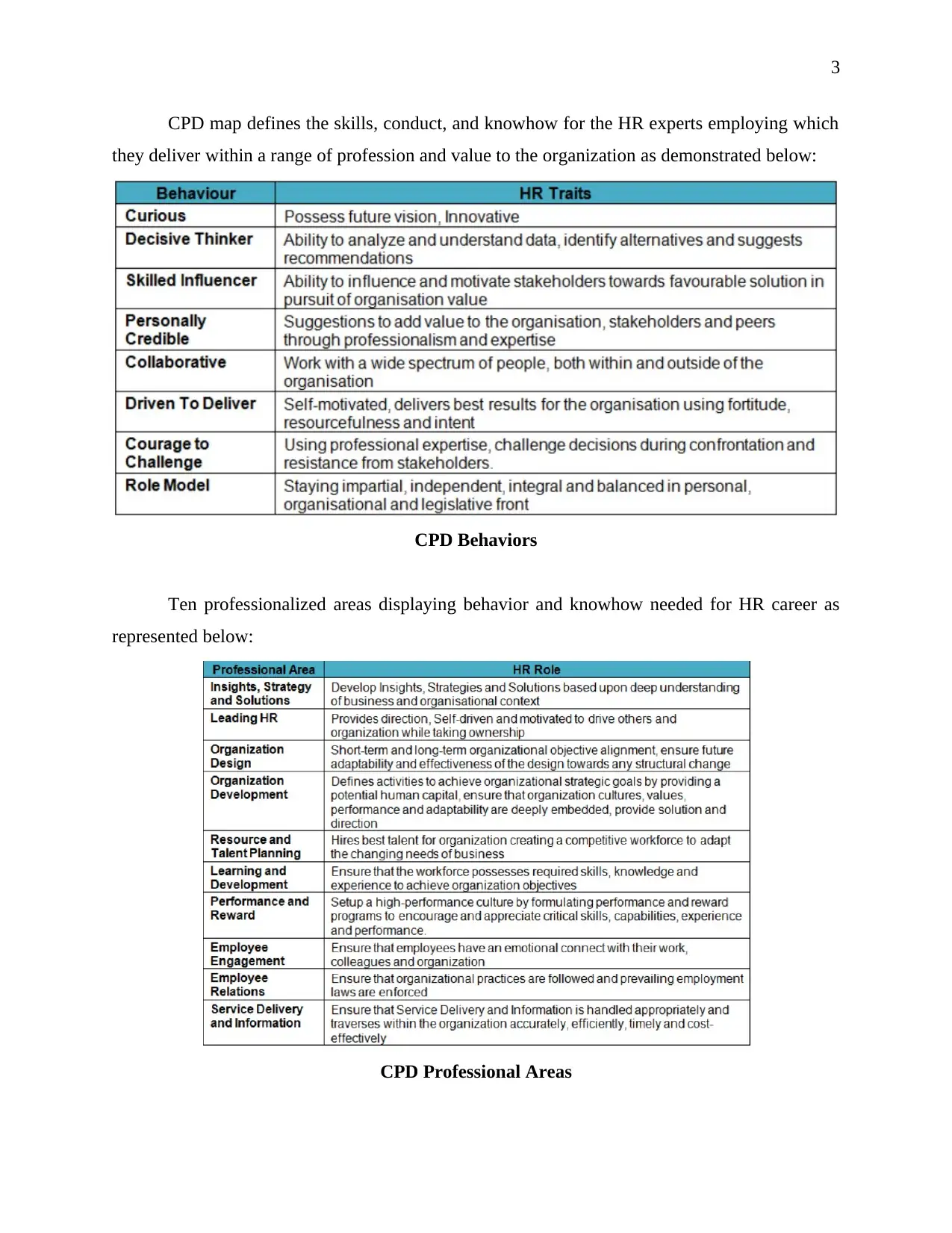
3
CPD map defines the skills, conduct, and knowhow for the HR experts employing which
they deliver within a range of profession and value to the organization as demonstrated below:
CPD Behaviors
Ten professionalized areas displaying behavior and knowhow needed for HR career as
represented below:
CPD Professional Areas
CPD map defines the skills, conduct, and knowhow for the HR experts employing which
they deliver within a range of profession and value to the organization as demonstrated below:
CPD Behaviors
Ten professionalized areas displaying behavior and knowhow needed for HR career as
represented below:
CPD Professional Areas
Paraphrase This Document
Need a fresh take? Get an instant paraphrase of this document with our AI Paraphraser
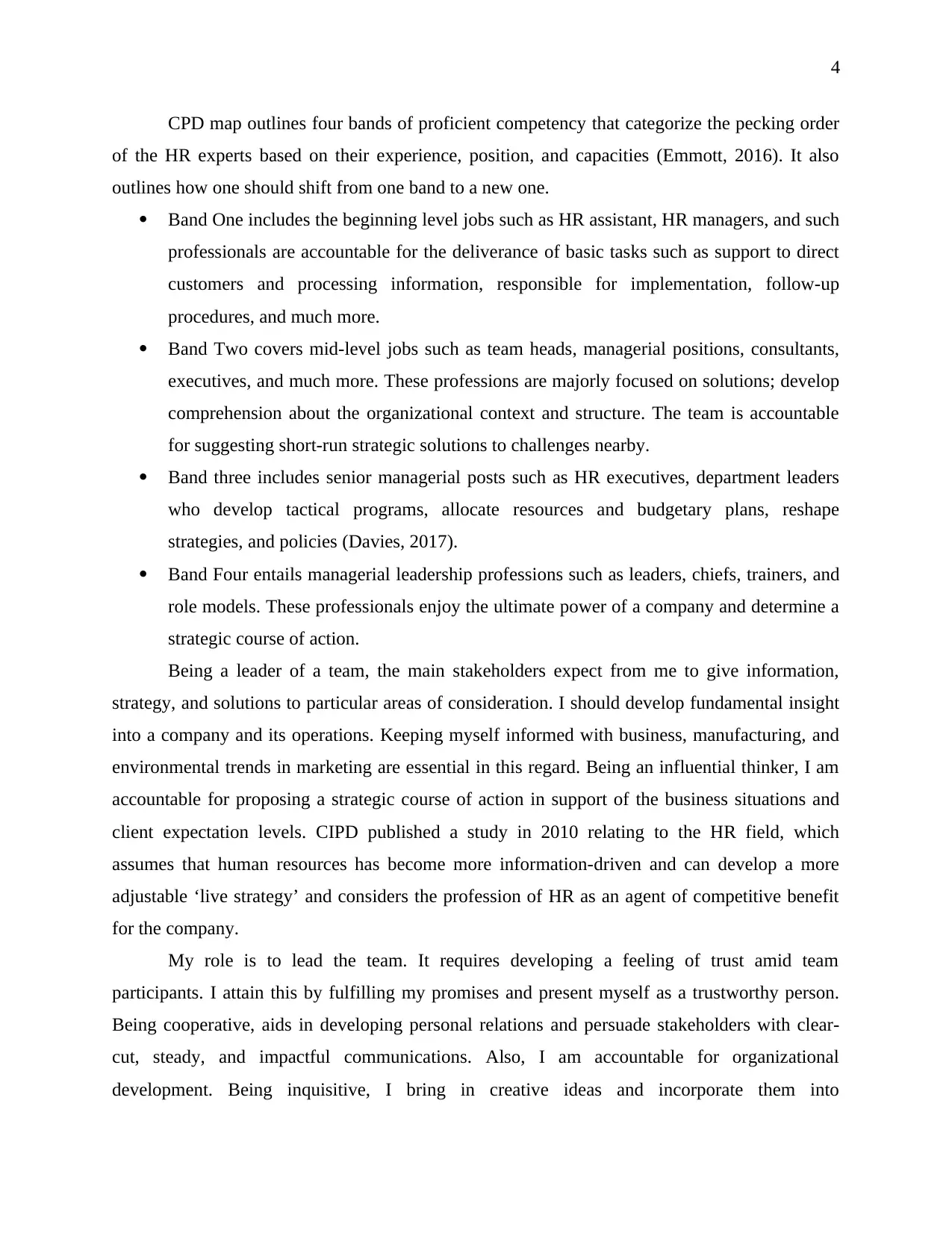
4
CPD map outlines four bands of proficient competency that categorize the pecking order
of the HR experts based on their experience, position, and capacities (Emmott, 2016). It also
outlines how one should shift from one band to a new one.
Band One includes the beginning level jobs such as HR assistant, HR managers, and such
professionals are accountable for the deliverance of basic tasks such as support to direct
customers and processing information, responsible for implementation, follow-up
procedures, and much more.
Band Two covers mid-level jobs such as team heads, managerial positions, consultants,
executives, and much more. These professions are majorly focused on solutions; develop
comprehension about the organizational context and structure. The team is accountable
for suggesting short-run strategic solutions to challenges nearby.
Band three includes senior managerial posts such as HR executives, department leaders
who develop tactical programs, allocate resources and budgetary plans, reshape
strategies, and policies (Davies, 2017).
Band Four entails managerial leadership professions such as leaders, chiefs, trainers, and
role models. These professionals enjoy the ultimate power of a company and determine a
strategic course of action.
Being a leader of a team, the main stakeholders expect from me to give information,
strategy, and solutions to particular areas of consideration. I should develop fundamental insight
into a company and its operations. Keeping myself informed with business, manufacturing, and
environmental trends in marketing are essential in this regard. Being an influential thinker, I am
accountable for proposing a strategic course of action in support of the business situations and
client expectation levels. CIPD published a study in 2010 relating to the HR field, which
assumes that human resources has become more information-driven and can develop a more
adjustable ‘live strategy’ and considers the profession of HR as an agent of competitive benefit
for the company.
My role is to lead the team. It requires developing a feeling of trust amid team
participants. I attain this by fulfilling my promises and present myself as a trustworthy person.
Being cooperative, aids in developing personal relations and persuade stakeholders with clear-
cut, steady, and impactful communications. Also, I am accountable for organizational
development. Being inquisitive, I bring in creative ideas and incorporate them into
CPD map outlines four bands of proficient competency that categorize the pecking order
of the HR experts based on their experience, position, and capacities (Emmott, 2016). It also
outlines how one should shift from one band to a new one.
Band One includes the beginning level jobs such as HR assistant, HR managers, and such
professionals are accountable for the deliverance of basic tasks such as support to direct
customers and processing information, responsible for implementation, follow-up
procedures, and much more.
Band Two covers mid-level jobs such as team heads, managerial positions, consultants,
executives, and much more. These professions are majorly focused on solutions; develop
comprehension about the organizational context and structure. The team is accountable
for suggesting short-run strategic solutions to challenges nearby.
Band three includes senior managerial posts such as HR executives, department leaders
who develop tactical programs, allocate resources and budgetary plans, reshape
strategies, and policies (Davies, 2017).
Band Four entails managerial leadership professions such as leaders, chiefs, trainers, and
role models. These professionals enjoy the ultimate power of a company and determine a
strategic course of action.
Being a leader of a team, the main stakeholders expect from me to give information,
strategy, and solutions to particular areas of consideration. I should develop fundamental insight
into a company and its operations. Keeping myself informed with business, manufacturing, and
environmental trends in marketing are essential in this regard. Being an influential thinker, I am
accountable for proposing a strategic course of action in support of the business situations and
client expectation levels. CIPD published a study in 2010 relating to the HR field, which
assumes that human resources has become more information-driven and can develop a more
adjustable ‘live strategy’ and considers the profession of HR as an agent of competitive benefit
for the company.
My role is to lead the team. It requires developing a feeling of trust amid team
participants. I attain this by fulfilling my promises and present myself as a trustworthy person.
Being cooperative, aids in developing personal relations and persuade stakeholders with clear-
cut, steady, and impactful communications. Also, I am accountable for organizational
development. Being inquisitive, I bring in creative ideas and incorporate them into
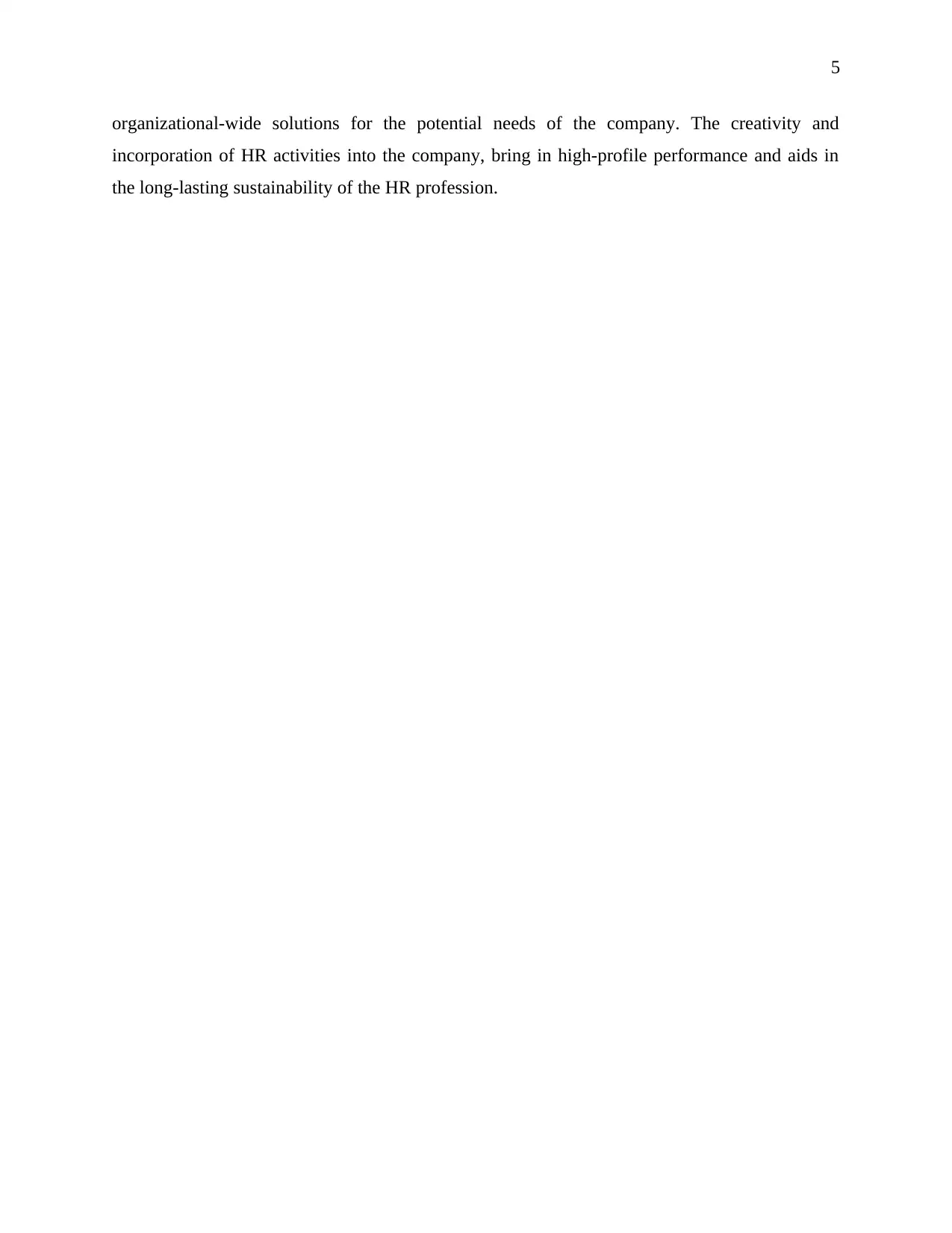
5
organizational-wide solutions for the potential needs of the company. The creativity and
incorporation of HR activities into the company, bring in high-profile performance and aids in
the long-lasting sustainability of the HR profession.
organizational-wide solutions for the potential needs of the company. The creativity and
incorporation of HR activities into the company, bring in high-profile performance and aids in
the long-lasting sustainability of the HR profession.
⊘ This is a preview!⊘
Do you want full access?
Subscribe today to unlock all pages.

Trusted by 1+ million students worldwide
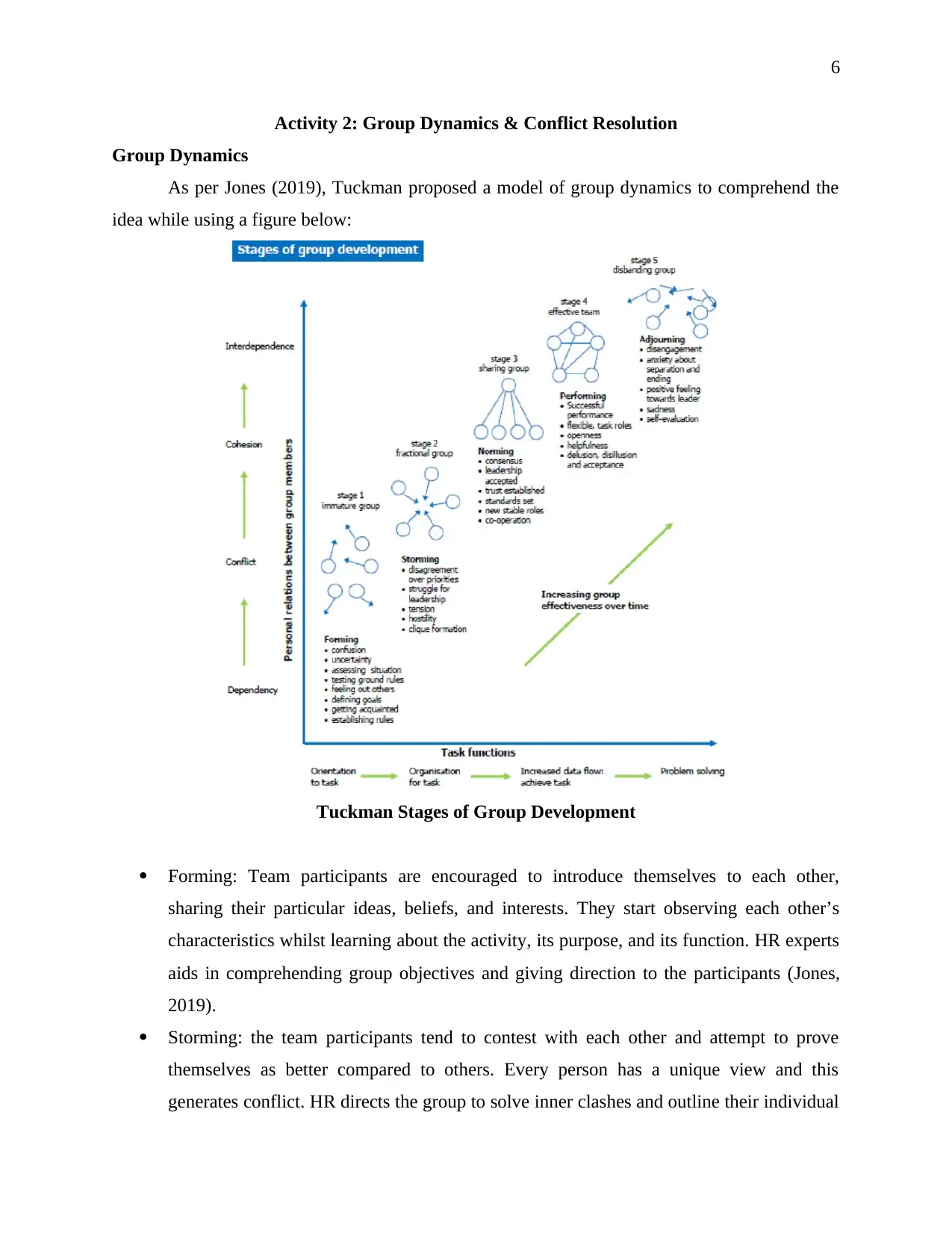
6
Activity 2: Group Dynamics & Conflict Resolution
Group Dynamics
As per Jones (2019), Tuckman proposed a model of group dynamics to comprehend the
idea while using a figure below:
Tuckman Stages of Group Development
Forming: Team participants are encouraged to introduce themselves to each other,
sharing their particular ideas, beliefs, and interests. They start observing each other’s
characteristics whilst learning about the activity, its purpose, and its function. HR experts
aids in comprehending group objectives and giving direction to the participants (Jones,
2019).
Storming: the team participants tend to contest with each other and attempt to prove
themselves as better compared to others. Every person has a unique view and this
generates conflict. HR directs the group to solve inner clashes and outline their individual
Activity 2: Group Dynamics & Conflict Resolution
Group Dynamics
As per Jones (2019), Tuckman proposed a model of group dynamics to comprehend the
idea while using a figure below:
Tuckman Stages of Group Development
Forming: Team participants are encouraged to introduce themselves to each other,
sharing their particular ideas, beliefs, and interests. They start observing each other’s
characteristics whilst learning about the activity, its purpose, and its function. HR experts
aids in comprehending group objectives and giving direction to the participants (Jones,
2019).
Storming: the team participants tend to contest with each other and attempt to prove
themselves as better compared to others. Every person has a unique view and this
generates conflict. HR directs the group to solve inner clashes and outline their individual
Paraphrase This Document
Need a fresh take? Get an instant paraphrase of this document with our AI Paraphraser
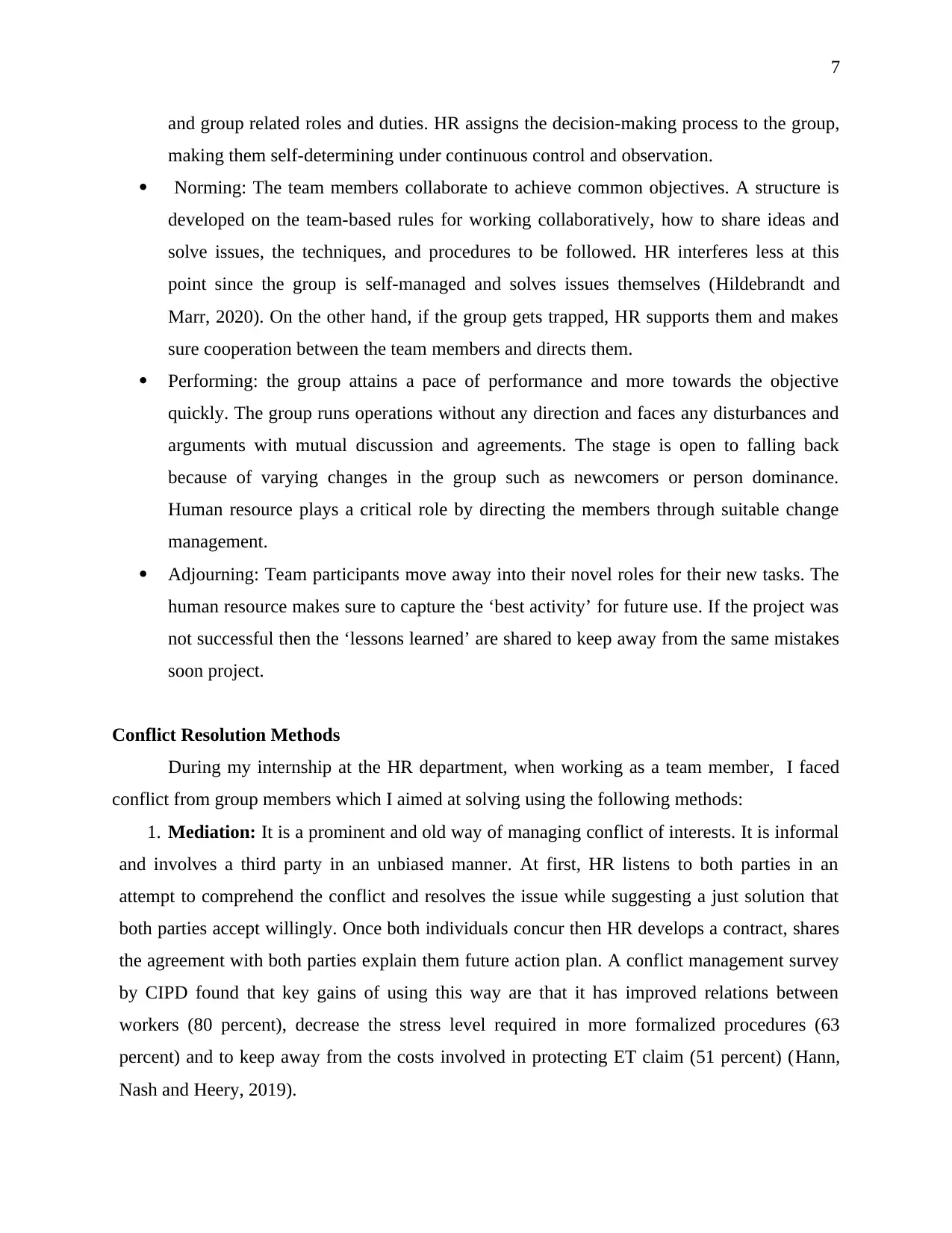
7
and group related roles and duties. HR assigns the decision-making process to the group,
making them self-determining under continuous control and observation.
Norming: The team members collaborate to achieve common objectives. A structure is
developed on the team-based rules for working collaboratively, how to share ideas and
solve issues, the techniques, and procedures to be followed. HR interferes less at this
point since the group is self-managed and solves issues themselves (Hildebrandt and
Marr, 2020). On the other hand, if the group gets trapped, HR supports them and makes
sure cooperation between the team members and directs them.
Performing: the group attains a pace of performance and more towards the objective
quickly. The group runs operations without any direction and faces any disturbances and
arguments with mutual discussion and agreements. The stage is open to falling back
because of varying changes in the group such as newcomers or person dominance.
Human resource plays a critical role by directing the members through suitable change
management.
Adjourning: Team participants move away into their novel roles for their new tasks. The
human resource makes sure to capture the ‘best activity’ for future use. If the project was
not successful then the ‘lessons learned’ are shared to keep away from the same mistakes
soon project.
Conflict Resolution Methods
During my internship at the HR department, when working as a team member, I faced
conflict from group members which I aimed at solving using the following methods:
1. Mediation: It is a prominent and old way of managing conflict of interests. It is informal
and involves a third party in an unbiased manner. At first, HR listens to both parties in an
attempt to comprehend the conflict and resolves the issue while suggesting a just solution that
both parties accept willingly. Once both individuals concur then HR develops a contract, shares
the agreement with both parties explain them future action plan. A conflict management survey
by CIPD found that key gains of using this way are that it has improved relations between
workers (80 percent), decrease the stress level required in more formalized procedures (63
percent) and to keep away from the costs involved in protecting ET claim (51 percent) (Hann,
Nash and Heery, 2019).
and group related roles and duties. HR assigns the decision-making process to the group,
making them self-determining under continuous control and observation.
Norming: The team members collaborate to achieve common objectives. A structure is
developed on the team-based rules for working collaboratively, how to share ideas and
solve issues, the techniques, and procedures to be followed. HR interferes less at this
point since the group is self-managed and solves issues themselves (Hildebrandt and
Marr, 2020). On the other hand, if the group gets trapped, HR supports them and makes
sure cooperation between the team members and directs them.
Performing: the group attains a pace of performance and more towards the objective
quickly. The group runs operations without any direction and faces any disturbances and
arguments with mutual discussion and agreements. The stage is open to falling back
because of varying changes in the group such as newcomers or person dominance.
Human resource plays a critical role by directing the members through suitable change
management.
Adjourning: Team participants move away into their novel roles for their new tasks. The
human resource makes sure to capture the ‘best activity’ for future use. If the project was
not successful then the ‘lessons learned’ are shared to keep away from the same mistakes
soon project.
Conflict Resolution Methods
During my internship at the HR department, when working as a team member, I faced
conflict from group members which I aimed at solving using the following methods:
1. Mediation: It is a prominent and old way of managing conflict of interests. It is informal
and involves a third party in an unbiased manner. At first, HR listens to both parties in an
attempt to comprehend the conflict and resolves the issue while suggesting a just solution that
both parties accept willingly. Once both individuals concur then HR develops a contract, shares
the agreement with both parties explain them future action plan. A conflict management survey
by CIPD found that key gains of using this way are that it has improved relations between
workers (80 percent), decrease the stress level required in more formalized procedures (63
percent) and to keep away from the costs involved in protecting ET claim (51 percent) (Hann,
Nash and Heery, 2019).
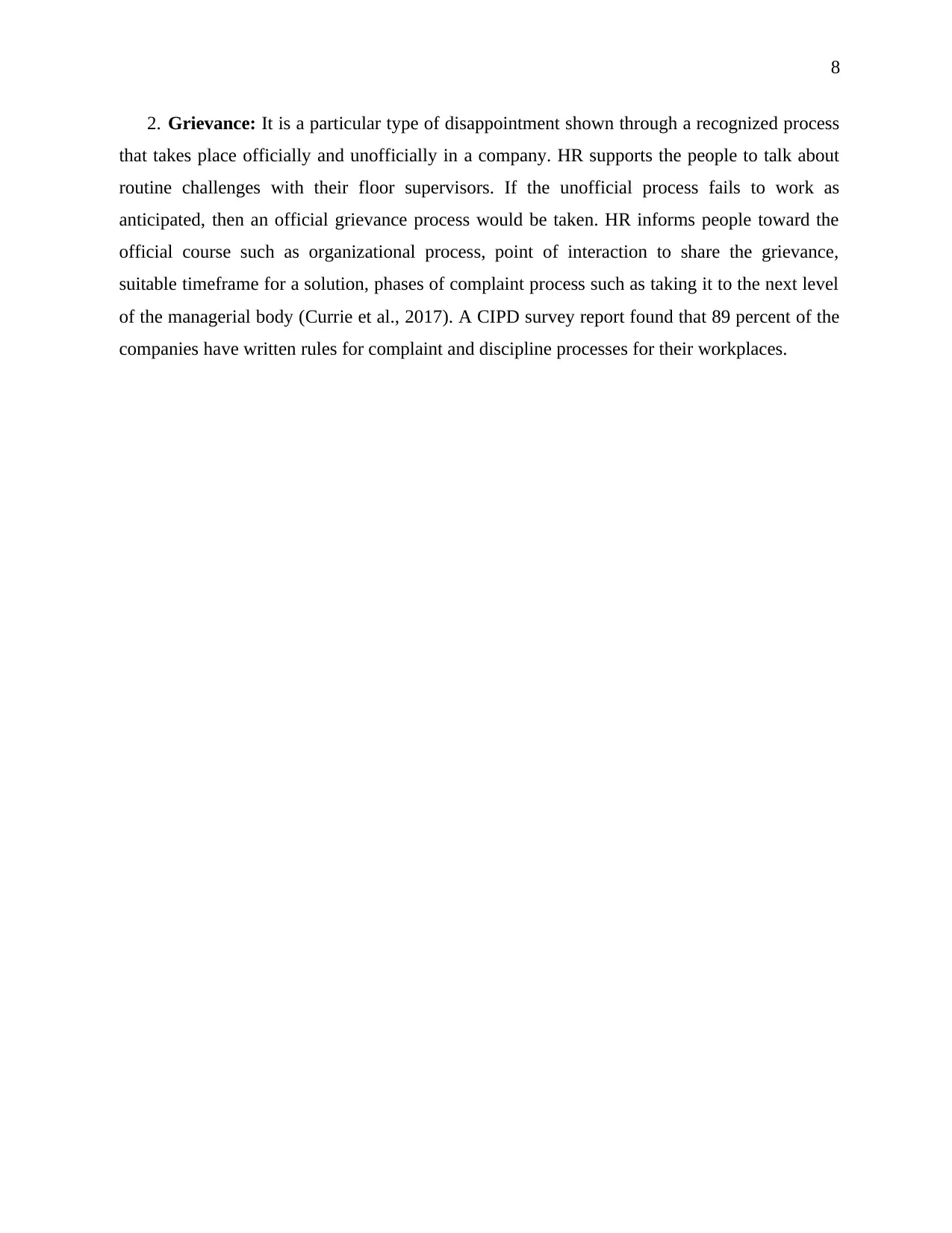
8
2. Grievance: It is a particular type of disappointment shown through a recognized process
that takes place officially and unofficially in a company. HR supports the people to talk about
routine challenges with their floor supervisors. If the unofficial process fails to work as
anticipated, then an official grievance process would be taken. HR informs people toward the
official course such as organizational process, point of interaction to share the grievance,
suitable timeframe for a solution, phases of complaint process such as taking it to the next level
of the managerial body (Currie et al., 2017). A CIPD survey report found that 89 percent of the
companies have written rules for complaint and discipline processes for their workplaces.
2. Grievance: It is a particular type of disappointment shown through a recognized process
that takes place officially and unofficially in a company. HR supports the people to talk about
routine challenges with their floor supervisors. If the unofficial process fails to work as
anticipated, then an official grievance process would be taken. HR informs people toward the
official course such as organizational process, point of interaction to share the grievance,
suitable timeframe for a solution, phases of complaint process such as taking it to the next level
of the managerial body (Currie et al., 2017). A CIPD survey report found that 89 percent of the
companies have written rules for complaint and discipline processes for their workplaces.
⊘ This is a preview!⊘
Do you want full access?
Subscribe today to unlock all pages.

Trusted by 1+ million students worldwide
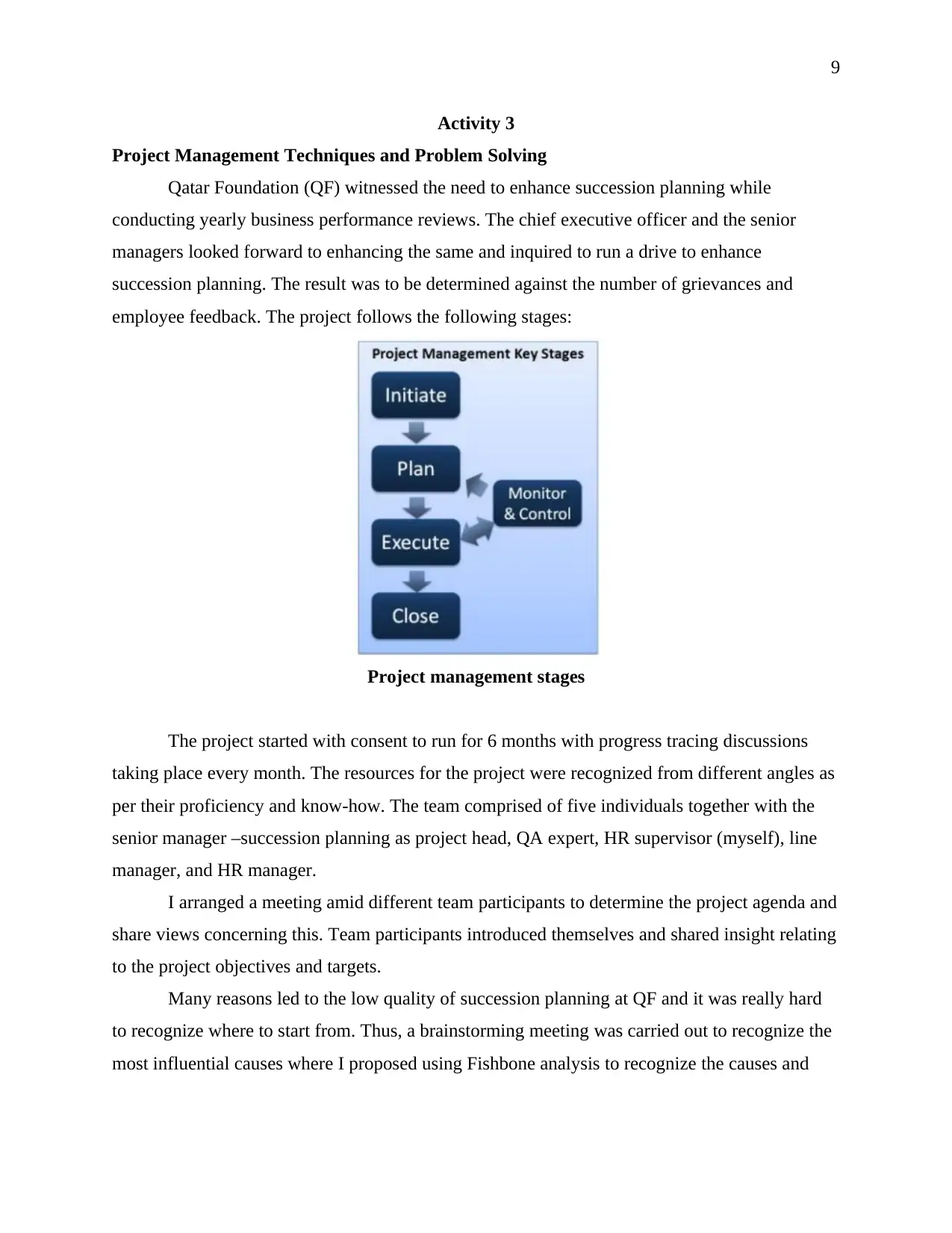
9
Activity 3
Project Management Techniques and Problem Solving
Qatar Foundation (QF) witnessed the need to enhance succession planning while
conducting yearly business performance reviews. The chief executive officer and the senior
managers looked forward to enhancing the same and inquired to run a drive to enhance
succession planning. The result was to be determined against the number of grievances and
employee feedback. The project follows the following stages:
Project management stages
The project started with consent to run for 6 months with progress tracing discussions
taking place every month. The resources for the project were recognized from different angles as
per their proficiency and know-how. The team comprised of five individuals together with the
senior manager –succession planning as project head, QA expert, HR supervisor (myself), line
manager, and HR manager.
I arranged a meeting amid different team participants to determine the project agenda and
share views concerning this. Team participants introduced themselves and shared insight relating
to the project objectives and targets.
Many reasons led to the low quality of succession planning at QF and it was really hard
to recognize where to start from. Thus, a brainstorming meeting was carried out to recognize the
most influential causes where I proposed using Fishbone analysis to recognize the causes and
Activity 3
Project Management Techniques and Problem Solving
Qatar Foundation (QF) witnessed the need to enhance succession planning while
conducting yearly business performance reviews. The chief executive officer and the senior
managers looked forward to enhancing the same and inquired to run a drive to enhance
succession planning. The result was to be determined against the number of grievances and
employee feedback. The project follows the following stages:
Project management stages
The project started with consent to run for 6 months with progress tracing discussions
taking place every month. The resources for the project were recognized from different angles as
per their proficiency and know-how. The team comprised of five individuals together with the
senior manager –succession planning as project head, QA expert, HR supervisor (myself), line
manager, and HR manager.
I arranged a meeting amid different team participants to determine the project agenda and
share views concerning this. Team participants introduced themselves and shared insight relating
to the project objectives and targets.
Many reasons led to the low quality of succession planning at QF and it was really hard
to recognize where to start from. Thus, a brainstorming meeting was carried out to recognize the
most influential causes where I proposed using Fishbone analysis to recognize the causes and
Paraphrase This Document
Need a fresh take? Get an instant paraphrase of this document with our AI Paraphraser
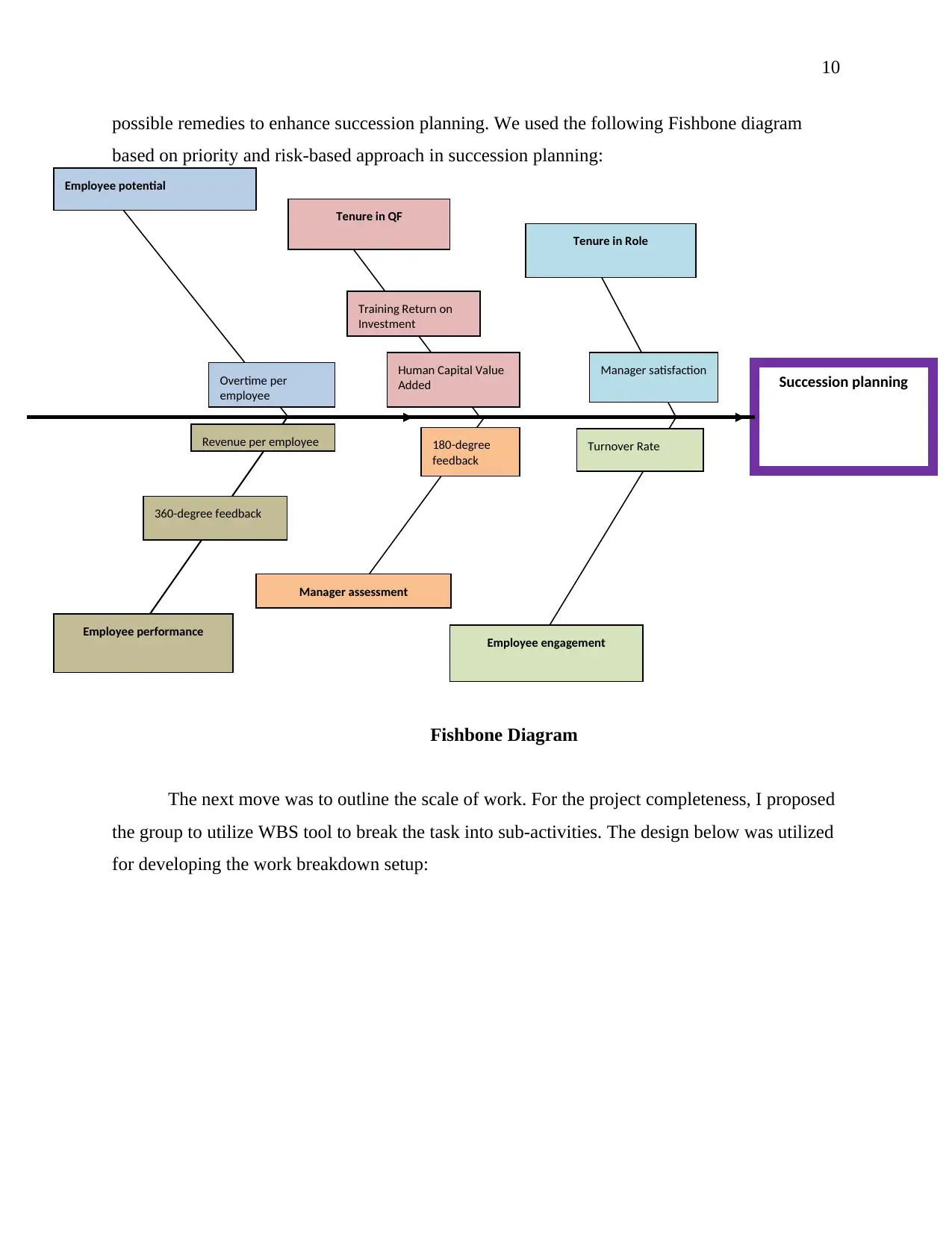
10
possible remedies to enhance succession planning. We used the following Fishbone diagram
based on priority and risk-based approach in succession planning:
Fishbone Diagram
The next move was to outline the scale of work. For the project completeness, I proposed
the group to utilize WBS tool to break the task into sub-activities. The design below was utilized
for developing the work breakdown setup:
Employee potential
Tenure in QF
Tenure in Role
Employee engagement
Manager assessment
Employee performance
Succession planningOvertime per
employee
Human Capital Value
Added
Revenue per employee Turnover Rate
Manager satisfaction
180-degree
feedback
Training Return on
Investment
360-degree feedback
possible remedies to enhance succession planning. We used the following Fishbone diagram
based on priority and risk-based approach in succession planning:
Fishbone Diagram
The next move was to outline the scale of work. For the project completeness, I proposed
the group to utilize WBS tool to break the task into sub-activities. The design below was utilized
for developing the work breakdown setup:
Employee potential
Tenure in QF
Tenure in Role
Employee engagement
Manager assessment
Employee performance
Succession planningOvertime per
employee
Human Capital Value
Added
Revenue per employee Turnover Rate
Manager satisfaction
180-degree
feedback
Training Return on
Investment
360-degree feedback
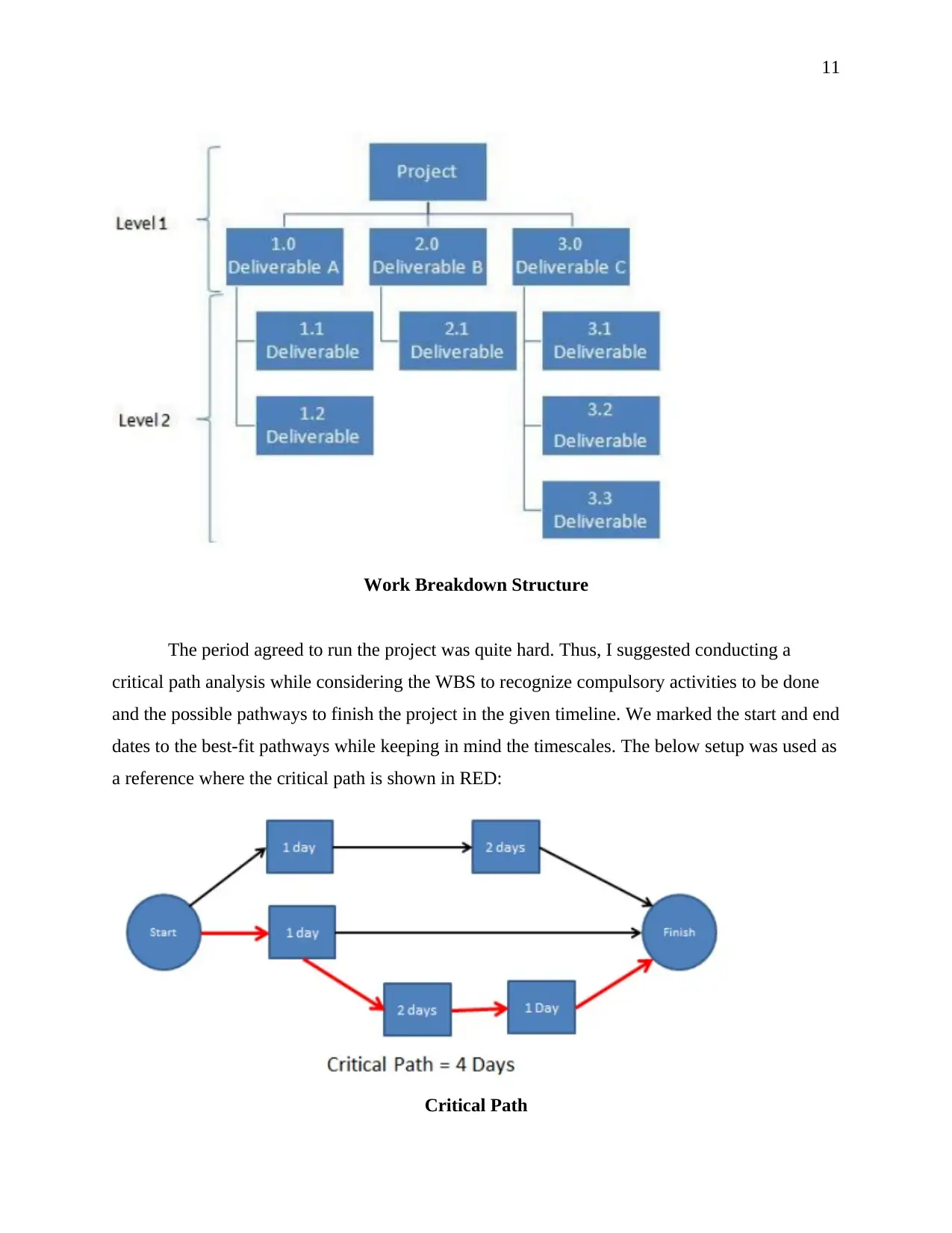
11
Work Breakdown Structure
The period agreed to run the project was quite hard. Thus, I suggested conducting a
critical path analysis while considering the WBS to recognize compulsory activities to be done
and the possible pathways to finish the project in the given timeline. We marked the start and end
dates to the best-fit pathways while keeping in mind the timescales. The below setup was used as
a reference where the critical path is shown in RED:
Critical Path
Work Breakdown Structure
The period agreed to run the project was quite hard. Thus, I suggested conducting a
critical path analysis while considering the WBS to recognize compulsory activities to be done
and the possible pathways to finish the project in the given timeline. We marked the start and end
dates to the best-fit pathways while keeping in mind the timescales. The below setup was used as
a reference where the critical path is shown in RED:
Critical Path
⊘ This is a preview!⊘
Do you want full access?
Subscribe today to unlock all pages.

Trusted by 1+ million students worldwide
1 out of 23
Related Documents
Your All-in-One AI-Powered Toolkit for Academic Success.
+13062052269
info@desklib.com
Available 24*7 on WhatsApp / Email
![[object Object]](/_next/static/media/star-bottom.7253800d.svg)
Unlock your academic potential
Copyright © 2020–2025 A2Z Services. All Rights Reserved. Developed and managed by ZUCOL.





